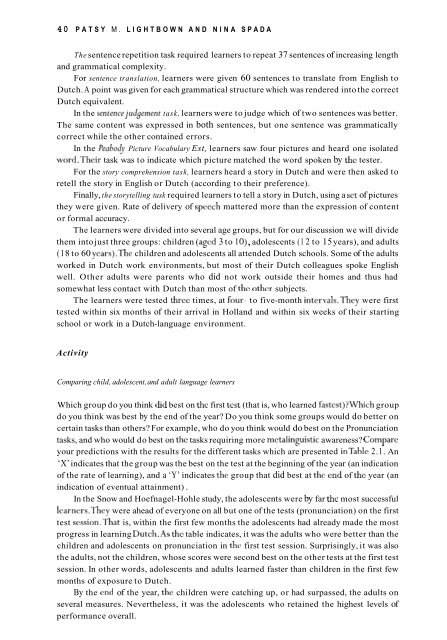English Language Teaching in its Social Context
English Language Teaching in its Social Context
English Language Teaching in its Social Context
Create successful ePaper yourself
Turn your PDF publications into a flip-book with our unique Google optimized e-Paper software.
40 PATSY M. LIGHTBOWN AND NINA SPADAThe sentence repetition task required learners to repeat 37 sentences of <strong>in</strong>creas<strong>in</strong>g lengthand grammatical complexity.For sentence translation, learners were given 60 sentences to translate from <strong>English</strong> toDutch. A po<strong>in</strong>t was given for each grammatical structure which was rendered <strong>in</strong>to the correctDutch equivalent.In the sentenceludgement task, learners were to judge which of two sentences was better.The same content was expressed <strong>in</strong> both sentences, but one sentence was grammaticallycorrect while the other conta<strong>in</strong>ed errors.In the Peabody Picture Vocabulary Est, learners saw four pictures and heard one isolatedword.Their task was to <strong>in</strong>dicate which picture matched the word spoken by the tester.For the story comprehension task, learners heard a story <strong>in</strong> Dutch and were then asked toretell the story <strong>in</strong> <strong>English</strong> or Dutch (accord<strong>in</strong>g to their preference).F<strong>in</strong>ally, the storytell<strong>in</strong>g task required learners to tell a story <strong>in</strong> Dutch, us<strong>in</strong>g a set of picturesthey were given. Rate of delivery of speech mattered more than the expression of contentor formal accuracy.The learners were divided <strong>in</strong>to several age groups, but for our discussion we will dividethem <strong>in</strong>to just three groups: children (aged 3 to lo), adolescents (1 2 to 15 years), and adults(1 8 to 60 ycars).The children and adolescents all attended Dutch schools. Some of the adultsworked <strong>in</strong> Dutch work environments, but most of their Dutch colleagues spoke <strong>English</strong>well. Other adults were parents who did not work outside their homes and thus hadsomewhat less contact with Dutch than most of the other subjects.The learners were tested three times, at four- to five-month <strong>in</strong>tervals.They were firsttested with<strong>in</strong> six months of their arrival <strong>in</strong> Holland and with<strong>in</strong> six weeks of their start<strong>in</strong>gschool or work <strong>in</strong> a Dutch-language environment.ActivityCompar<strong>in</strong>g child, adolescent, and adult language learnersWhich group do you th<strong>in</strong>k (lid best on the first test (that is, who learned fastcst)?Which groupdo you th<strong>in</strong>k was best by the end of the year? Do you th<strong>in</strong>k some groups would do better oncerta<strong>in</strong> tasks than others? For example, who do you th<strong>in</strong>k would do best on the Pronunciationtasks, and who would do best on the tasks requir<strong>in</strong>g more mctal<strong>in</strong>guistic awareness? Compareyour predictions with the results for the different tasks which are presented <strong>in</strong>Table 2.1. An‘X’ <strong>in</strong>dicates that the group was the best on the test at the beg<strong>in</strong>n<strong>in</strong>g of the year (an <strong>in</strong>dicationof the rate of learn<strong>in</strong>g), and a ‘Y’ <strong>in</strong>dicates the group that did best at the end of the year (an<strong>in</strong>dication of eventual atta<strong>in</strong>ment) .In the Snow and Hoefnagel-Hohle study, the adolescents were by far the most successful1carners.They were ahead of everyone on all but one of the tests (pronunciation) on the firsttest session.That is, with<strong>in</strong> the first few months the adolescents had already made the mostprogress <strong>in</strong> learn<strong>in</strong>g Dutch.As the table <strong>in</strong>dicates, it was the adults who were better than thechildren and adolescents on pronunciation <strong>in</strong> the first test session. Surpris<strong>in</strong>gly, it was alsothe adults, not the children, whose scores were second best on the other tests at the first testsession. In other words, adolescents and adults learned faster than children <strong>in</strong> the first fewmonths of exposure to Dutch.By the end of the year, the children were catch<strong>in</strong>g up, or had surpassed, the adults onseveral measures. Nevertheless, it was the adolescents who reta<strong>in</strong>ed the highest levels ofperformance overall.












